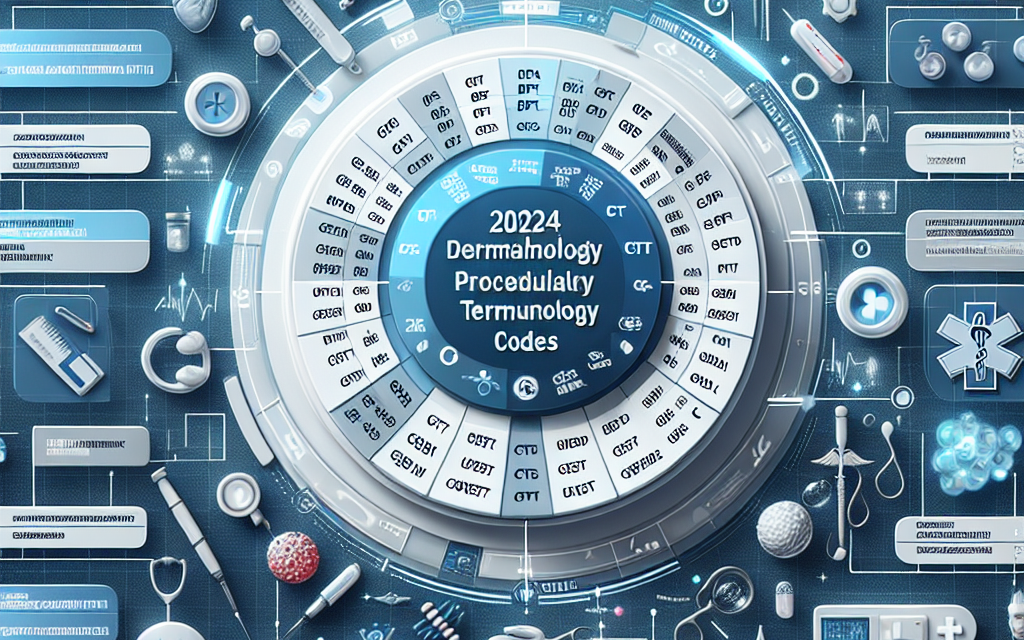2024 Dermatology CPT Codes Overview | Nextech
The field of dermatology is constantly evolving, with new treatments and technologies emerging regularly. As a result, the Current Procedural Terminology (CPT) codes used to document and bill for dermatological services must also evolve. In 2024, several updates and changes to dermatology CPT codes are expected, impacting how dermatologists and their practices operate. This article provides a comprehensive overview of the 2024 dermatology CPT codes, focusing on key changes, their implications, and how Nextech can assist practices in navigating these updates.
Understanding CPT Codes in Dermatology
CPT codes are essential for the standardized documentation and billing of medical procedures and services. In dermatology, these codes cover a wide range of services, from routine skin examinations to complex surgical procedures. Understanding these codes is crucial for dermatologists to ensure accurate billing and reimbursement.
The Role of CPT Codes in Dermatology
CPT codes serve several critical functions in dermatology. They provide a standardized language for describing medical procedures, which facilitates communication between healthcare providers, insurance companies, and patients. This standardization is essential for ensuring that dermatologists are reimbursed accurately for their services.
Moreover, CPT codes help in tracking healthcare trends and outcomes. By analyzing the frequency and distribution of specific codes, researchers and policymakers can gain insights into the prevalence of certain conditions and the effectiveness of various treatments.
Key Changes in 2024 Dermatology CPT Codes
The 2024 updates to dermatology CPT codes include several significant changes. These changes reflect advancements in dermatological treatments and aim to improve the accuracy and efficiency of billing processes. Some of the key changes include:
- Introduction of new codes for emerging treatments and technologies.
- Revisions to existing codes to reflect updated clinical guidelines.
- Deletion of outdated codes that no longer reflect current practice.
These changes are designed to ensure that CPT codes remain relevant and useful in the rapidly evolving field of dermatology.
Implications of CPT Code Changes for Dermatology Practices
The changes to dermatology CPT codes in 2024 have several implications for dermatology practices. First, practices must update their billing systems and processes to reflect the new codes. This may require training staff on the changes and updating software systems to ensure accurate billing.
Additionally, the changes may impact reimbursement rates for certain procedures. Practices must stay informed about these changes to ensure they are billing correctly and receiving appropriate reimbursement for their services.
Finally, the changes may affect how practices document and report their services. Dermatologists must ensure that their documentation accurately reflects the services provided and aligns with the updated CPT codes.
Case Studies: Navigating CPT Code Changes
Several dermatology practices have successfully navigated previous changes to CPT codes, providing valuable insights for others facing similar challenges. For example, a large dermatology practice in California implemented a comprehensive training program for its staff to ensure they understood the new codes and their implications. This proactive approach helped the practice avoid billing errors and maintain accurate reimbursement rates.
Another practice in New York leveraged technology to streamline its billing processes. By integrating its electronic health record (EHR) system with its billing software, the practice was able to automate many aspects of the billing process, reducing the risk of errors and improving efficiency.
Statistics on Dermatology CPT Code Utilization
Statistics on the utilization of dermatology CPT codes provide valuable insights into trends in the field. According to recent data, the most commonly used dermatology CPT codes include those for skin examinations, biopsies, and excisions. These codes account for a significant portion of dermatology billing and reflect the high demand for these services.
Additionally, the data shows an increasing use of codes for advanced treatments, such as laser therapy and Mohs surgery. This trend reflects the growing popularity of these treatments and the need for accurate coding to ensure proper reimbursement.
Navigating the 2024 Dermatology CPT Code Changes with Nextech
Nextech is a leading provider of healthcare technology solutions, offering a range of tools and resources to help dermatology practices navigate the 2024 CPT code changes. With its comprehensive suite of software solutions, Nextech can assist practices in updating their billing processes, training staff, and ensuring compliance with the new codes.
Nextech’s Comprehensive Software Solutions
Nextech offers a range of software solutions designed to streamline the billing and documentation processes for dermatology practices. These solutions include electronic health records (EHR) systems, practice management software, and billing solutions that are fully integrated and customizable to meet the unique needs of each practice.
By leveraging Nextech’s software solutions, dermatology practices can automate many aspects of the billing process, reducing the risk of errors and improving efficiency. This automation is particularly valuable in light of the 2024 CPT code changes, as it ensures that practices can quickly and accurately update their billing processes to reflect the new codes.
Training and Support for Dermatology Practices
Nextech provides comprehensive training and support to help dermatology practices navigate the 2024 CPT code changes. This support includes training sessions for staff on the new codes and their implications, as well as ongoing support to address any questions or challenges that may arise.
By providing this training and support, Nextech helps practices ensure that their staff is well-prepared to handle the changes and maintain accurate billing and documentation processes. This support is essential for minimizing disruptions to practice operations and ensuring continued compliance with coding requirements.
Case Study: A Practice’s Success with Nextech
A dermatology practice in Florida successfully navigated the 2024 CPT code changes with the help of Nextech’s software solutions and support. The practice implemented Nextech’s EHR and practice management software, which allowed them to automate their billing processes and ensure accurate coding.
Additionally, the practice participated in Nextech’s training sessions, which provided their staff with the knowledge and skills needed to handle the changes. As a result, the practice was able to maintain accurate billing and reimbursement rates, minimizing disruptions to their operations.
Benefits of Using Nextech for Dermatology Practices
There are several benefits to using Nextech’s software solutions and support for dermatology practices. These benefits include:
- Improved accuracy and efficiency in billing processes.
- Reduced risk of errors and compliance issues.
- Comprehensive training and support for staff.
- Customizable solutions to meet the unique needs of each practice.
By leveraging these benefits, dermatology practices can navigate the 2024 CPT code changes with confidence and ensure continued success in their operations.
Statistics on Nextech’s Impact on Dermatology Practices
Statistics on the impact of Nextech’s solutions on dermatology practices highlight the value of these tools and resources. According to recent data, practices that use Nextech’s software solutions experience a significant reduction in billing errors and an increase in reimbursement rates.
Additionally, practices that participate in Nextech’s training and support programs report higher levels of staff satisfaction and confidence in handling coding changes. These statistics underscore the importance of leveraging technology and support to navigate the complexities of dermatology CPT code changes.
Preparing for Future Changes in Dermatology CPT Codes
While the 2024 changes to dermatology CPT codes are significant, it is important for practices to prepare for future changes as well. The field of dermatology is constantly evolving, and practices must stay informed about new developments and updates to coding requirements.
Staying Informed About CPT Code Changes
One of the most important steps dermatology practices can take to prepare for future CPT code changes is to stay informed about new developments. This includes regularly reviewing updates from the American Medical Association (AMA) and other relevant organizations, as well as participating in industry conferences and events.
By staying informed, practices can anticipate changes and take proactive steps to update their processes and systems. This proactive approach is essential for minimizing disruptions and ensuring continued compliance with coding requirements.
Leveraging Technology to Adapt to Changes
Technology plays a critical role in helping dermatology practices adapt to changes in CPT codes. By leveraging advanced software solutions, practices can automate many aspects of the billing and documentation processes, reducing the risk of errors and improving efficiency.
Additionally, technology can help practices stay informed about new developments and updates to coding requirements. Many software solutions offer features that automatically update coding information and provide alerts about changes, ensuring that practices are always up-to-date.
Training and Education for Staff
Training and education are essential for preparing staff to handle changes in CPT codes. Practices should invest in ongoing training programs that provide staff with the knowledge and skills needed to navigate coding changes and maintain accurate billing processes.
By providing this training, practices can ensure that their staff is well-prepared to handle changes and maintain compliance with coding requirements. This investment in training is essential for minimizing disruptions and ensuring continued success in practice operations.
Case Study: A Practice’s Proactive Approach to CPT Code Changes
A dermatology practice in Texas took a proactive approach to preparing for future CPT code changes. The practice implemented a comprehensive training program for its staff, which included regular updates on coding changes and best practices for billing and documentation.
Additionally, the practice leveraged technology to automate its billing processes and stay informed about new developments. By taking these proactive steps, the practice was able to navigate the 2024 CPT code changes with ease and is well-prepared for future updates.
Statistics on the Importance of Preparation for CPT Code Changes
Statistics on the importance of preparation for CPT code changes highlight the value of staying informed and leveraging technology. According to recent data, practices that take a proactive approach to preparing for coding changes experience fewer disruptions and higher levels of compliance.
Additionally, practices that invest in training and education for their staff report higher levels of staff satisfaction and confidence in handling coding changes. These statistics underscore the importance of preparation in navigating the complexities of dermatology CPT code changes.
Conclusion: Key Takeaways for Dermatology Practices
The 2024 updates to dermatology CPT codes present both challenges and opportunities for dermatology practices. By understanding these changes and their implications, practices can take proactive steps to update their processes and systems, ensuring continued success in their operations.
Nextech offers a range of tools and resources to help practices navigate these changes, including comprehensive software solutions, training, and support. By leveraging these resources, practices can improve the accuracy and efficiency of their billing processes, reduce the risk of errors, and maintain compliance with coding requirements.
Looking ahead, it is important for practices to stay informed about future changes in CPT codes and take proactive steps to prepare. By investing in training and education for staff and leveraging technology, practices can navigate the complexities of coding changes with confidence and ensure continued success in their operations.





